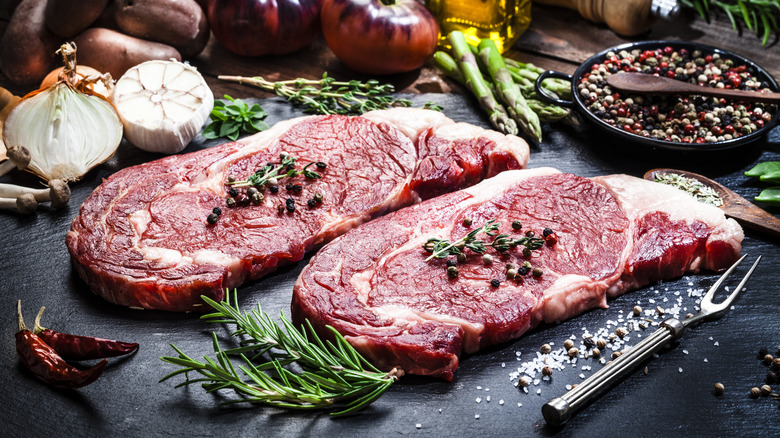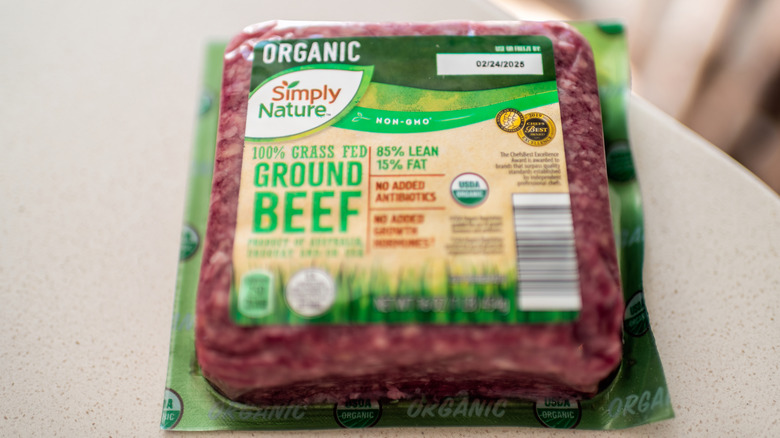Grass-Fed Vs Organic Beef: Is There A Difference?
Shopping for good beef can be a deceptively difficult task. Other than standard signs of quality like color and marbling, there are also several marketing terms whose meanings may seem intuitively clear, but they're a bit more particular under the surface. One common confusion is the difference between grass-fed and organic beef.
Both options are popular with consumers who want to buy better-tasting beef. Both generally have higher standards for these labels than regular beef cattle, which may spend most of their lives on crowded feedlots with minimal space and a carefully-balanced diet made of multiple components, such as corn, wheat, and various vegetable scraps, engineered toward maximum growth instead of the animal's quality of life.
Grass-fed and organic beef, on the other hand, have stricter standards for what type of food the cattle eats. But while organic labels allow for a range of feed options that may or may not include grass, grass-fed beef is typically just that: cattle that are fed on grass. Mostly, at least.
What is grass-fed beef?
According to the USDA, grass-fed beef comes from any cattle that only ate forage after being weaned from its mother's milk. As a category, forage mostly comprises grass, though other vegetation like hay and various legumes are allowed, essentially anything a cow might find while foraging for food on a cow pasture. This also includes silage, which is cut grass and other pasture trimmings put in a silo for storage and fermentation.
This may sound strictly regulated, but in 2016 the USDA revoked the program that proactively regulated "grass-fed" labeling on beef. It is still monitored by the USDA's Food Safety and Inspection Services, but not strictly regulated. Rather than in-person farm inspections by federal employees, farmers simply have to send in paperwork attesting to the cattle's grass-fed nature.
For the consumer, grass-fed beef has to be cooked at lower temperatures than grain-fed beef, because of the absence of fatty fortifiers in the cattle's diet. But the end result is worth the effort. And it doesn't have to be expensive, either. For instance, the discount grocery chain Aldi sells grass-fed ground beef, which is sometimes organic as well.
What is organic beef?
Organic beef is similar to and can include grass-fed beef, but the regulations around the cattle's diet are a bit different. From the animal's last third of gestation, the USDA requires all organic beef to have year-round outdoor access, weather permitting, to certified organic land, which is free of pesticides and fertilizers. Other animal welfare standards for organic beef not shared by other kinds include access to shade, clean bedding, and exercise space.
Organic beef also must be fed with 100% organic feed. Unlike the grass and silage eaten by grass-fed beef, organic feed can theoretically be anything that does not contain antibiotics, animal byproducts, added growth hormones, and other banned ingredients like arsenic compounds. Certified organic feed also cannot be grown with chemical fertilizers or pesticides. If farmland is certified organic, then the silage eaten by its grass-fed cows is likely also organic, hence the occasional overlap.
Organic versus grass fed may be a big dividing line in the beef world (with some notable crossover in between) but it's far from the only one. Be sure to check out our ultimate guide to understanding meat labels, for the basics on all-natural, free range, and other labels you might see on beef, or any other meat.


